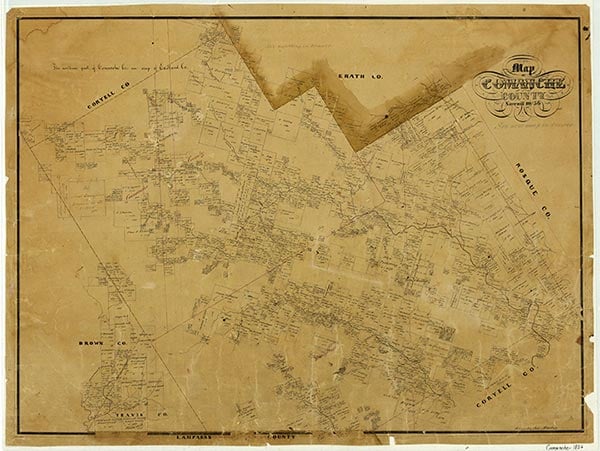Troy

Cora, the first seat of Comanche County, was about sixteen miles southeast of Comanche on the South Leon River in southeastern Comanche County. The county was formed and organized in 1856, and the next year F. A. Thomson and J. E. Bouldin donated eighty acres of the W. H. Murray survey, overlooking the river, for a county seat. The site was beside the Fort Gates and Fort Phantom Hill Road that had already brought people into the area. The community applied for a post office to be called Troy, but the application was denied since there was already a Troy in Bell County. Thomas C. Frost, county land agent, suggested the name Cora, for Miss Cora Beeman, daughter of Maj. Alonzo Beeman of Moffat, Bell County. This name was accepted, and James M. Cross, who had opened the first store in Cora in 1857, was appointed postmaster. Within a year, the community had two stores and a steam saw and grist mill. The town of Cora flourished until 1858, when some Comanche County land was made part of Hamilton County. This left Cora too far from the center of Comanche County to qualify as the county seat. The town of Comanche was created, and the county government moved there in July 1859. Though Indian problems slowed the local settlement rate after 1858, the 1860 census showed Cora to be a community of twenty-five houses, of which twenty-three were occupied. The 136 individuals reported as residents at that time made up nearly 20 percent of the county population and included twelve farmers or stock raisers, four mechanics, three merchants, two wagonmakers, two blacksmiths, two wagoners, two millers, a house carpenter, a schoolteacher, and a trader. Cora declined, and its post office closed in 1867. Old building foundations were visible at the site as late as 1880. By 1900, however, nothing remained of the community but the cemetery, which is today situated well back on private property. The few grave markers left by the 1990s in the unfenced cemetery dated from between 1859 and 1893; the cemetery also included many unmarked graves. Part of the log structure that had served as the first courthouse had been moved to a site on the bluff overlooking the river, where it was used as a residence.
Margaret Tate Waring | © TSHA

Adapted from the official Handbook of Texas, a state encyclopedia developed by Texas State Historical Association (TSHA). It is an authoritative source of trusted historical records.

- ✅ Adoption Status:
- This place is available for adoption! Available for adoption!
- Adopted by:
- Your name goes here
- Dedication Message:
- Your message goes here
Belongs to
Troy is part of or belongs to the following places:
Currently Exists
No
Place type
Troy is classified as a Town
Associated Names
- (Cora)
Has Post Office
No
Is Incorporated
No
